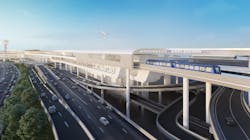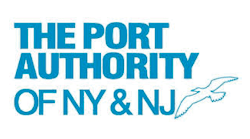The Federal Aviation Administration (FAA) issued its Record of Decision for the LaGuardia Airport (LGA) AirTrain project, clearing the way for the Port Authority of New York and New Jersey (PANYNJ) to pursue future funding under the Passenger Facility Charge program.
The program allows for the collection of fees added to passenger tickets proceeds of which can be used on certain qualifying airport projects, subject to FAA approval.
The $2-billion project would provide a rail transit connection to the final major U.S. airport on the East Coast without one. PANYNJ plans to connect LGA to the New York City Transit Subway 7 Line and the Long Island Rail Road Port Washington Branch at Mets-Willets Point. Additionally, there will also be passenger walkways connecting to the LGA Central Hall, a parking garage connector, public transportation and ground transportation facilities.
The proposed automatic people mover aims to increase reliability of travel times between LaGuardia and New York City, enhance airport access for passengers and employees, reduce nearby off-airport traffic congestion and increase availability of employee parking and expand airport areas for storage of equipment and materials for maintenance activities.
PANYNJ Executive Director Rick Cotton thanked the FAA for conducting “an exhaustive and independent environmental review” and noted the decision is a more that will provide “a reliable, predictable and non-polluting rail link to LaGuardia Airport.”
“LaGuardia Airport is the only major airport on the East Coast without a rail mass transit link and it is way past time for that embarrassment to end,” said Cotton. “The LaGuardia AirTrain will provide a sustainable and reliable travel option to LaGuardia Airport. It will remove millions of vehicles from congested highways and local roads each year. The transformative AirTrain project will help drive the region’s economic recovery by creating 3,000 union construction jobs and more than $500 million in business contracting opportunities for minority and women-owned businesses and local, Queens-based businesses. It also includes a historic investment of $50 million in the Malcolm X Promenade along Flushing Bay and other neighborhood parks. Additionally, the LaGuardia AirTrain includes a robust package of other community benefits, from investments in workforce development programs for local residents and strong local hiring requirements, to STEM programming and college scholarships for local students.”
The Final Environmental Impact Statement was released on March 19, 2021, following input from 18 different federal, state and local agencies. FAA says it collected 4,200 comments on the project and its virtual public hearings on the project were viewed by more than 18,000 people.
“With construction on supporting infrastructure set to begin this summer, the Port Authority will continue offering regular engagement opportunities for local residents throughout the construction period to ensure transparency and accountability. The community will receive regular updates on the project, as well as on progress on community benefit commitments and will have an open line of communication with project staff to address any questions or concerns,” said Cotton.
A Better Way to LGA Coalition said the move by FAA is cause for celebration.
"Today’s decision confirms what hundreds of business leaders, transportation advocates, community members, labor unions, and civic stakeholders have known for months: this environmentally-friendly transportation link will provide reliable, sustainable, 21st century access to the new LaGuardia Airport, while helping to drive the economic recovery of the region that was among the nation’s hardest hit by COVID-19,” the coalition said.

Mischa Wanek-Libman | Group Editorial Director
Mischa Wanek-Libman is director of communications with Transdev North America. She has more than 20 years of experience working in the transportation industry covering construction projects, engineering challenges, transit and rail operations and best practices.
Wanek-Libman has held top editorial positions at freight rail and public transportation business-to-business publications including as editor-in-chief and editorial director of Mass Transit from 2018-2024. She has been recognized for editorial excellence through her individual work, as well as for collaborative content.
She is an active member of the American Public Transportation Association's Marketing and Communications Committee and served 14 years as a Board Observer on the National Railroad Construction and Maintenance Association (NRC) Board of Directors.
She is a graduate of Drake University in Des Moines, Iowa, where she earned a Bachelor of Arts degree in Journalism and Mass Communication.




